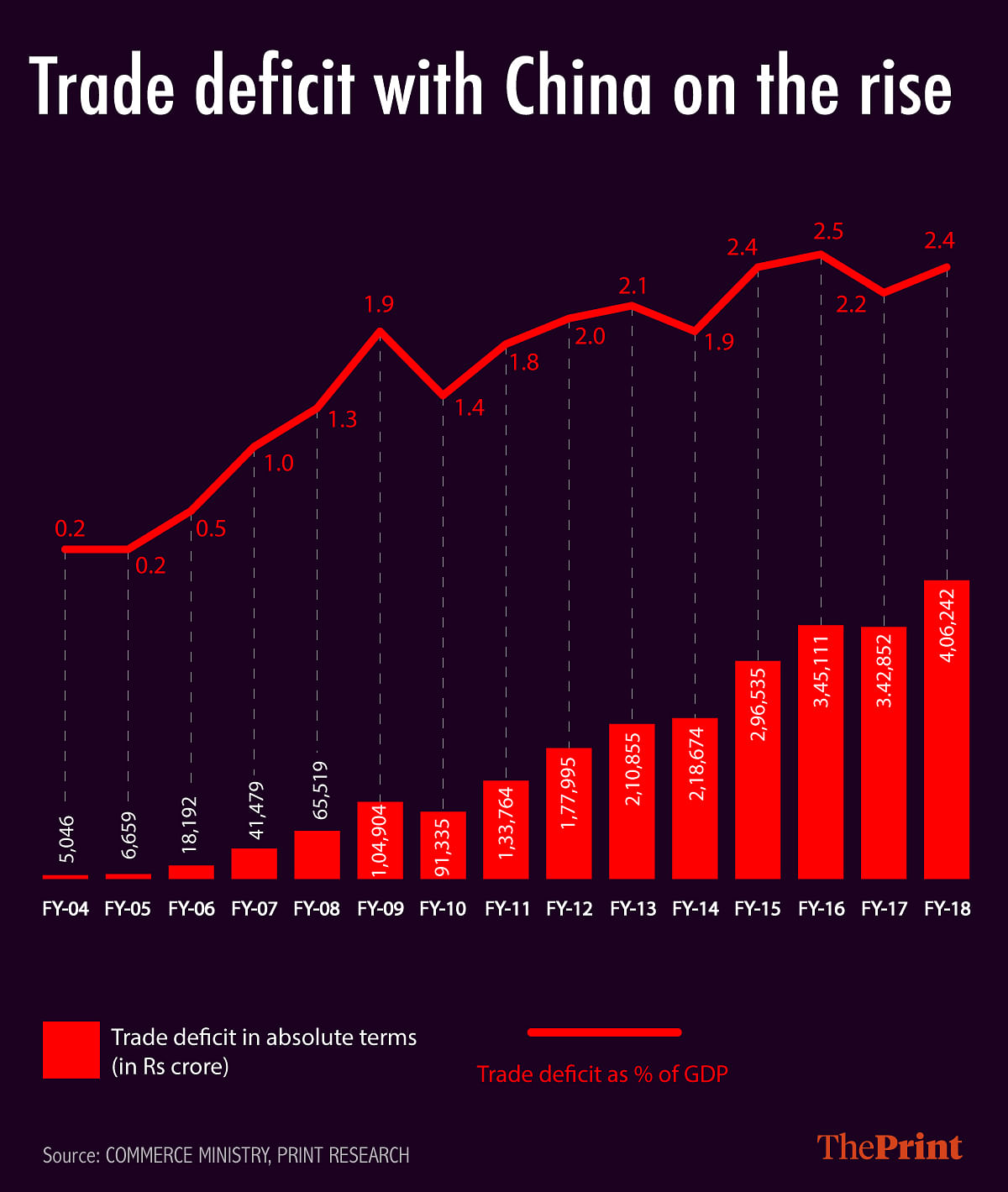Data shows India’s deficit with China now hovers at 2.4%, as of March 2018. The peak was in fiscal 2015-16 at 2.5%.
New Delhi: In the last decade, India’s trade deficit with China has been rising steadily, staying above 2 per cent of gross domestic product since 2011-12, with the exception of 2013-14.
Government data shows the deficit now hovers at 2.4 per cent, as of March 2018, having peaked in fiscal 2015-16 at 2.5 per cent.
Until 2006-07, trade deficit with China was only at 1 per cent of GDP or lower, reflecting the rapid rise of Chinese imports over the last few years.
In absolute terms also, the trade deficit has been increasing since 2010-11 with the exception of 2016-17, when there was a marginal fall, indicating India’s growing dependence on Chinese goods to meet the demands of the local market.
India’s trade deficit with China rose to Rs 4.06 lakh crore in 2017-18, up by 18% from Rs 3.42 lakh crore in the year ago period. In absolute terms, the trade deficit has risen many fold since the levels prevailing in 2003-04. Trade deficit was at Rs 5,046 crore in 2003-04.
During the last 10 years, while exports to China have only doubled, imports from China have more than tripled widening the deficit.

Imports from China, mainly in manufactured products, meet the demand of India’s telecom and power sectors. The major imports from China include telecom instruments, computer hardware and peripherals, fertilizers, electronic components/instruments, project goods, organic chemicals and drug intermediates, consumer electronics, electrical machinery and equipment, iron and steel etc.
India’s exports to China, however, are mainly raw materials subject to commodity price fluctuations.
Also read: India’s trade deficit biggest in five years, to worsen outlook for Indian rupee
‘No strategy’
Trade experts expect that the deficit could come down in the current 2018-19 fiscal as India’s exports to China improve as a consequence of the US-China trade war.
“India does not have a strategy on how to augment our exports to China. It is all ad-hoc and that does not work,” said T.S. Vishwanath, principal adviser at APJ-SLG Law offices.
“Things have improved recently with China far more receptive for opening up imports. But we are still not out of the woods. The dependence on China will increase once RCEP comes into place,” he said.
The RCEP or the Regional Comprehensive Economic Partnership is a proposed free trade agreement among the 10 ASEAN member states.
“The increasing deficit reflects the demand generated by the Indian economy which is being met through imports. Power plant equipment, telecom equipment, salt, chemical and fertilizer imports have been the major imports from China,” said Ajay Sahai, director general and CEO, Federation of Indian Export Organisation.
“It underlines the fact that domestic industry has not been able to provide substitution.”
“India mainly exports raw materials to China and a fall in commodity prices in 2016 impacted exports. However, 2018-19 has been encouraging,” he said.
Trade war
The US-China tariff war has seen India’s exports in the July-November period of this fiscal rise at an impressive growth rate.
Exports of auto components, pharmaceuticals, organic and special chemicals and plastic products have picked up, said Sahai.
In addition, market access to some of India’s agricultural commodities has also helped some items like soyabean, rapeseed and sugar, he said.
The Indian government has been trying to reduce the trade deficit by efforts to increase market access for Indian agricultural products, animal feeds, oil seeds, milk and milk products, pharmaceutical products etc. in light of the potential of these products or services in the Chinese market.
Customs duty imposed in 2018-19 has also helped domestic industry become competitive though it is unlikely to slow down imports, he added.
Also read: China wants to convince India to join Asian free trade pact



